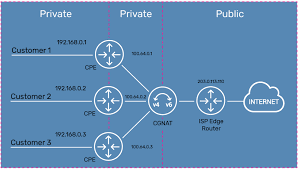Carrier Grade Network Address Translation

© copyright a10networks.com
In a home computer network the usual organisation is that the router will have a unique IPv4 address, something like 85.255.255.191. Any device that is connected to the router will have a local IPv4 address such as 192.168.1.154. This address is local to the router. Each device used the same external IP address and the router manages the requests and responses using NAT (Network Address Translation).
The Internet is based on the HTTP request - response protocol. Requests for an Internet resource initiate at the client devices, go through the router making it straightforward for the router to channel the response to the correct device. However if you want to host a web-server or a camera-stream at home the request comes from outside the home, outside the router's environment sending the request to the correct local device becomes difficult. So within a router you can associate ports to specific devices; port 80 is usually a web server, 554 a comera stream. The request for such services need a port number attached to the IP address
Why is this important to mobile phone technology? Because this is exactly how IP addresses are allocated to a mobile phone, they have a local (to Vodafone or O2, or EE or 3) address with the equivalent to the home router sitting within the operator network. This is large scale NAT routing or CGNAT. Using CGNAT makes not difference to the use of the mobile phone's use of the Internet. But it does make a difference to mobile broadband. You cannot set up port forwarding on mobile broadband network if the network is using CGNAT technology. Thus standard mobile broadband is NOT the same as home broadband.
Are there ways around this? Yes you can use a third party L2TP (Layer 2 Tunnelling Protocol) service at a small cost for domestic and small business users. [aa.net.uk provide such a service]
The reason for all this complex routing is that we have run out of IPv4 addresses. But we have IPv6 addresses which are 32 hexadecimal numbers, which can uniquely identify as many devices as we could ever imagine. Another way to get around this problem with mobile broadband is to persuade the mobile operator to change to IPv6 networks.
*u* ©mobilephonetechnology.co.uk all rights reserved 2017- 2025



